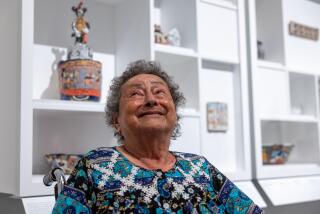San Francisco Museum of Modern Art turns 75 with a splash
When Grace McCann Morley became director of the San Francisco Museum of Art in 1935, she knew what she wanted to focus on: the art of her time. “If art of today is today overlooked or misunderstood, the loss is serious,” she once wrote. “Art fails then to give its full value to daily life.”
She championed such artists as Klee, Matisse and Picasso and gave first solo museum shows to Clyfford Still, Arshile Gorky and a young Jackson Pollock. It was only some 40 years later, long after Morley had ended her tenure, that the museum finally got the word “modern” inserted into its title, befitting the art it had shown and collected and the institution it had become.
Today, the San Francisco Museum of Modern Art celebrates its 75th anniversary with several major exhibitions. exploring its own history and that of modern art. The tentpole is “The Anniversary Show” (until Jan. 16, 2011) with 400 works, mostly from its own holdings, while “The View from Here” (until June 27) surveys California photography. June will bring the first major exhibition of the celebrated Fisher collection, put together by Doris and the late Donald Fisher, the founders of Gap, and in November by “How Wine Became Modern.”
“To some extent, having an anniversary encourages you to relearn and reexamine your own legacy,” says Neal Benezra, director of the museum. “As we quickly discovered, the legacy is really one of innovation, from the get-go.” He acknowledges the progressive standards set by Morley, who served 23 years in the job until 1958. “The history of American museums is often one of women trustees hiring male directors,” he says. “In our case, it was a board of men trustees hiring a female director. It was a very unorthodox history.”
In hindsight, Morley seemed ideally suited for the challenge of setting up the first modern art museum on the West Coast -- well educated and well traveled, she had her finger on the pulse of modernity. After graduating from UC Berkeley, she went to the Sorbonne for a PhD in French literature and art, cultivating a taste for the avant-garde. Sometimes this proved difficult for San Francisco audiences -- a letter of complaint about a Braque painting in a 1939 exhibition and Morley’s graceful response are featured in one display case. She also made savvy acquisitions and developed relationships with artists, collectors and dealers. During her tenure the museum pioneered art appreciation lectures, traveling exhibitions and even a television show.
A focused approach
Today, the museum has a collection of 28,000 works of art and a staff of 240, housed in a whimsical Mario Botta building opened in 1995 -- it has a bold red brick facade topped with a cylindrical post-modern turret -- in downtown’s South of Market area. Last May the original exhibition space was boosted with the completion of a rooftop garden. Plans to house the Fisher collection involve tearing down adjacent buildings, which, in this preservation-minded city, could present obstacles.
While other museums have been facing contraction because of the recession, sometimes compounded by bad management, SFMOMA seems to be holding its own. Benezra dealt with a rough patch when he took over in 2002 -- facing a $2-million debt, partly because of the bursting of the dot.com bubble. He cut the budget, slowed the exhibition schedule and stretched resources. The museum has ridden through the current bad patch without layoffs, he says.
What is the museum’s scope? “We collect photography from its invention in 1840s,” says Benezra. “In other areas, we collect throughout the 20th century, focused on the contemporary period. Something very important to me is that there’s a big distinction between what a museum of modern art and what a museum of contemporary art does -- a museum of modern art has a more expansive scope, both in time and in terms of audience.”
“The Anniversary Show” tells the story of the museum and of modern art with text, photographs and ephemera as well as 18 galleries of art. A team of three curators worked on it. Two of them, Janet Bishop, curator of painting and sculpture, and Sarah Roberts, associate curator of collections and research, provide a walk-through. (The third is Corey Keller, associate curator of photography.)
“One of our ideas was to point to moments where individuals really made an extraordinary contribution,” Bishop says. Thus, the first gallery is dedicated to the museum’s first major benefactor, businessman Albert Bender, who contributed1,100 works in all. Early on he recognized the talents of photographers Edward Weston and Ansel Adams, both of whom have work in the gallery, as well as an artist much farther away -- Diego Rivera. Bender purchased a number of Rivera’s drawings (later donated to the museum) and helped arrange commissions for the Mexican artist to do murals at the San Francisco Art Institute and the Stock Exchange.
In 1930 Frida Kahlo accompanied her husband to the city and ended up painting a famous double portrait of Rivera and herself, happily holding hands. The painting, dedicated to Bender, is in the show.
The next gallery, Roberts explains, is a salute to Morley and “her efforts to show and collect the roots of contemporary art, early 20th century European modernists primarily.” There is Matisse’s seminal”Femme au Chapeau” (1905), an experimental painting of the artist’s hat-wearing wife. Morley befriended the painting’s owners, Sarah and Michael Stein (brother of Gertrude), when they moved back to the Bay Area after 30 years in France. In 1991 the painting was donated to SFMOMA.
After the museum mounted the landmark Jackson Pollock show in 1945, Morley wrote to his dealer Peggy Guggenheim about her favorite work, “Guardians of the Secret,” “It is a powerful and fine painting. However, our funds are very small . . .” When the dealer granted a discount ($500 rather than $750), Morley persuaded her acquisitions committee to take the offer.
In the early 1970s collectors Harry W. and Mary Margaret Anderson gave three important works by Robert Rauschenberg, Clyfford Still and Jasper Johns. They followed that up in 1992 with seven major Pop art works. When the museum moved into the new building in 1995, some questioned whether the collection was up to par with it. Almost as in response, art patron Phyllis Wattis helped the museum acquire key works by Magritte, Mondrian, Andy Warhol, Eva Hesse and Wayne Thiebaud.
Perhaps the most exciting part of the anniversary celebration isn’t even up yet: the exhibition of the Fisher Collection, considered one of the world’s top private collections of contemporary art. Under a special agreement, “Calder to Warhol: Introducing the Fisher Collection” will show about 160 works. The collection comprises more than 1,100 works, notable for its depth in such major 20th century artists as Alexander Calder, Chuck Close, Anselm Kiefer, Roy Lichtenstein, Agnes Martin and Richard Serra. At one point the Fishers looked into building their own museum in the Presidio, but residents protested -- and prevailed.
“We’re still in the process of crafting the exact arrangement,” says Benezra, “but when all is said and done, that collection of 1,100 works will come to live under this much larger roof. It will make this museum a must destination for seeing the art of our time.”
More to Read
The biggest entertainment stories
Get our big stories about Hollywood, film, television, music, arts, culture and more right in your inbox as soon as they publish.
You may occasionally receive promotional content from the Los Angeles Times.










